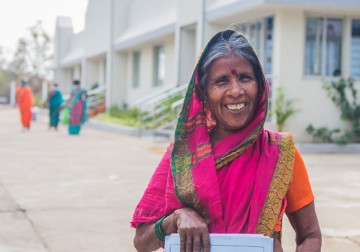A new study by Dr Varsha Rathi and others from the Allen Foster Community Eye Health Research Centre, Gullapalli Pratibha Rao International Centre for Advancement of Rural Eye care (GPR-ICARE) with Dr Sheila MacNeil and colleagues from the University of Sheffield, UK analyzed the clinical outcomes and financial impact of early treatment of corneal abrasions and ulcers versus outcomes of delayed treatment.
Corneal abrasions are superficial scratches to the cornea. An unmanaged corneal abrasion can lead to infection, and a corneal ulcer (a painful sore). Timely treatment of a corneal abrasion is critical. Delayed treatment can damage the cornea leading to corneal ulceration, opacity and then vision loss, and sometimes even the loss of an eye. Many times, patients resort to home remedies or traditional healers, thereby increasing the risk of infections.
Corneal ulcers are a key cause of corneal blindness, a ‘silent epidemic,’ especially in low- and middle-income countries (LMICs) where rural agriculture is a key form of employment. Agricultural activities in a rural, tropical setting may result in corneal abrasions, and then corneal ulcers. Once infection sets in, treatment can be challenging and requires access to good-quality eye care facilities. However, LMICs only have few tertiary-level eye care facilities limited to urban locations, reducing opportunities for access. This makes patients put off accessing treatment, leading to lost livelihoods, and increasing costs of late treatment. There is growing evidence to show that treating early-stage corneal abrasions leads to good clinical outcomes.
A new paper in The Lancet Regional Health – Southeast Asia by Dr Varsha Rathi and her colleagues estimates the clinical and financial impact of early versus delayed presentation of corneal abrasions and ulcers. The paper focuses on two key aspects impacting clinical outcomes: the time of presentation and the size of ulcer. It compares these two parameters against data from a retrospective study of patients with corneal abrasion (861) and corneal ulcers (1821), with a prospective study of corneal abrasions (134 patients), based on patients at LVPEI’s primary and secondary centers. The paper also leverages the unique LVPEI pyramidal network of primary, secondary, and tertiary centers to model costs to the health system and to the patient.
Both retrospective and prospective datasets showed that clinical outcomes were better when patients visited LVPEI centres early, and when the ulcers were small (under 16mm2). ‘Bottom-up’ costing helped the study to establish that treatment and access costs are negligible at early stages, especially at primary centres. The cost of care and cost of access balloons as treatment is delayed—and it also leads to poorer outcomes. For example, the paper notes a ten-fold increase in the need for therapeutic keratoplasty among patients presenting with ulcers at secondary centres (1.7%) compared to tertiary centres (20.2%), where tertiary care is accessed late. The study is effective evidence for the impact of high-quality, permanent eye care facilities in rural and semi-rural locations.
‘Early treatment not only gave the best clinical results, but was also very economical to patients,' says Dr Varsha Rathi, one of the authors, and consultant ophthalmologist at GPR ICARE, LVPEI. 'Delaying access to treatment meant the patients needed to travel to more specialist facilities for more complex, often surgical treatment. Our paper presents a clear case for early local treatment of corneal abrasions.’
‘This is the power of health economics: it can provide numerical answers to clinical questions, in this case justifying the development of early treatments and further treatments which can be administered topically,’ notes Dr Sheila MacNeil, Department of Materials Science Engineering, University of Sheffield, UK.
Citation
Varsha M. Rathi, Praveen Thokala, Sheila MacNeil, Rohit C. Khanna, Peter N. Monk, Prashant Garg, Early treatment of corneal abrasions and ulcers–estimating clinical and economic outcomes, The Lancet Regional Health - Southeast Asia, Volume 4, 2022, 100038, ISSN 2772-3682, https://doi.org/10.1016/j.lansea.2022.100038.
Photo credit: A happy patient at the Mudhole secondary centre, by Srinivas Marmamula



